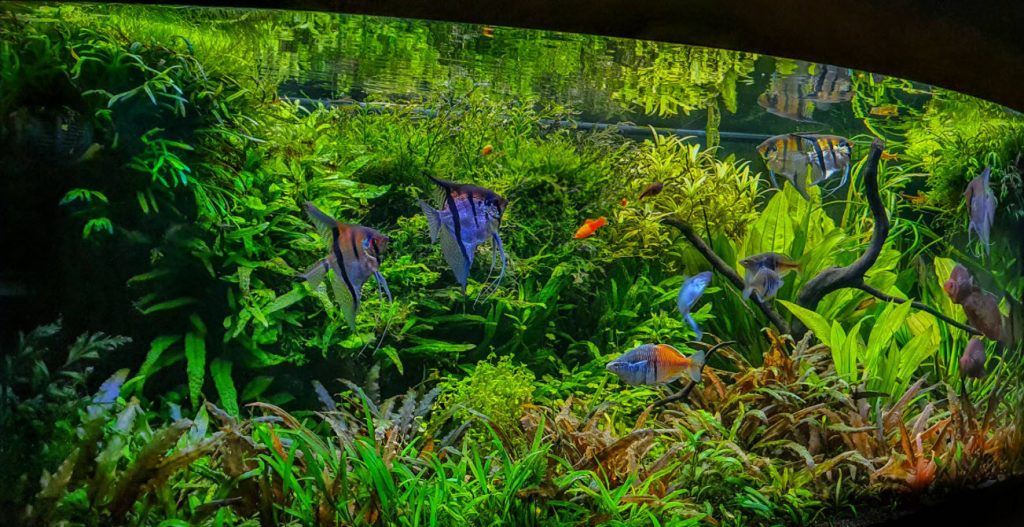
Testing Aquarium Filter Media for Effect on Water Clarity
Abstract
Clarity of the water was measured for ten 40 gallon aquariums with different filter media in canister filters and a heavy load of food. Four tests were run totaling some thirty aquarium and canister filters for some three months each.
The second test used half the media that the first test used. The third test used twice the media of the first test. A fourth test used actual fish fry in five aquariums with five different media.
In the first test four media out of the ten produced crystal clear water. In the second test (half the media) only one media, the foam, gave crystal clear water. All the other media gave dull water in both tests. In the third test (twice the media) only the five low performing media were tested and NONE of them gave crystal clear water. The fourth test simply confirmed that the presence of fish did not change the outcome of the tests.
These tests largely confirmed that crystal clear water requires some twenty times the filter media effective surface area that ammonia oxidation requires. This “rule” was confirmed in the scientific literature.
As usual at this hierarchical level, this lengthy discussion is only for real nerds, like the author.
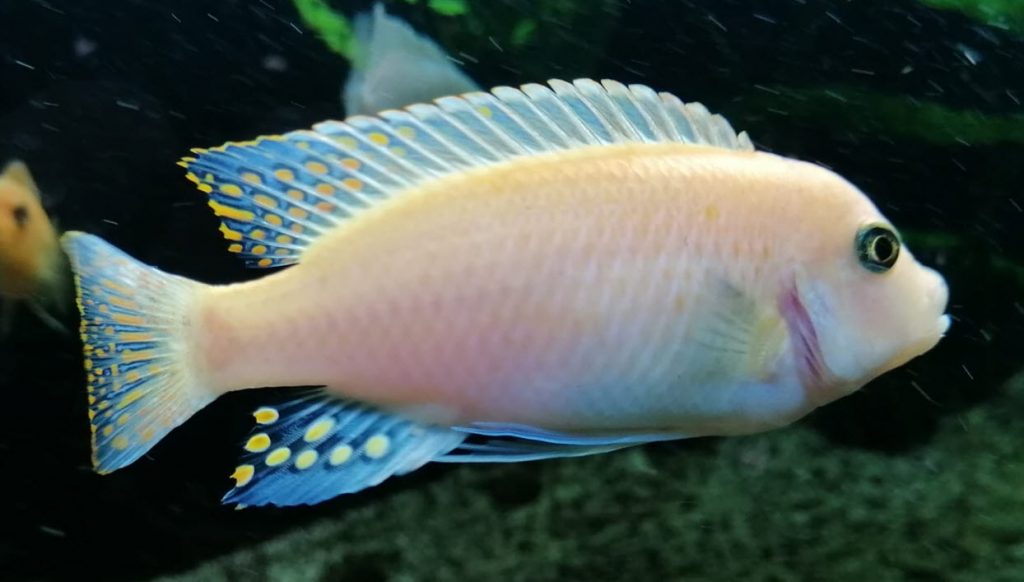
Test
Forty gallon tanks (five forty gallon tanks set up twice) were set up with Sunsun HW 304 B canister filters (~one half cubic foot of media, 370 GPH) on them. Various media was then placed in the filter. This was the only media in the filter. Each of the tanks was well aerated by a wavemaker aimed at the surface to produce a large area of “choppy waves”.
Brown squeezings from an established tank and sodium phosphate were put in at the start of each test. The tanks were then cycled with two grams per day of commercial dry flakes fish food and no fish. This is a high loading guaranteed to produce infusoria and a lot of cloudy water. Several dry runs with established media in filters showed this loading to be guaranteed to produce very cloudy water in matter of days. The tests were each run for ninety days. The pH was kept above 7.4 by adding baking soda when the pH dropped.
Tests of ammonia levels showed all the aquariums and all the filter media were successfully cycled in two weeks. They all oxidized the ammonia produced by the rotting food in 24 hours (i.e. there was less than 0.25 ammonia and nitrite in all the aquariums).
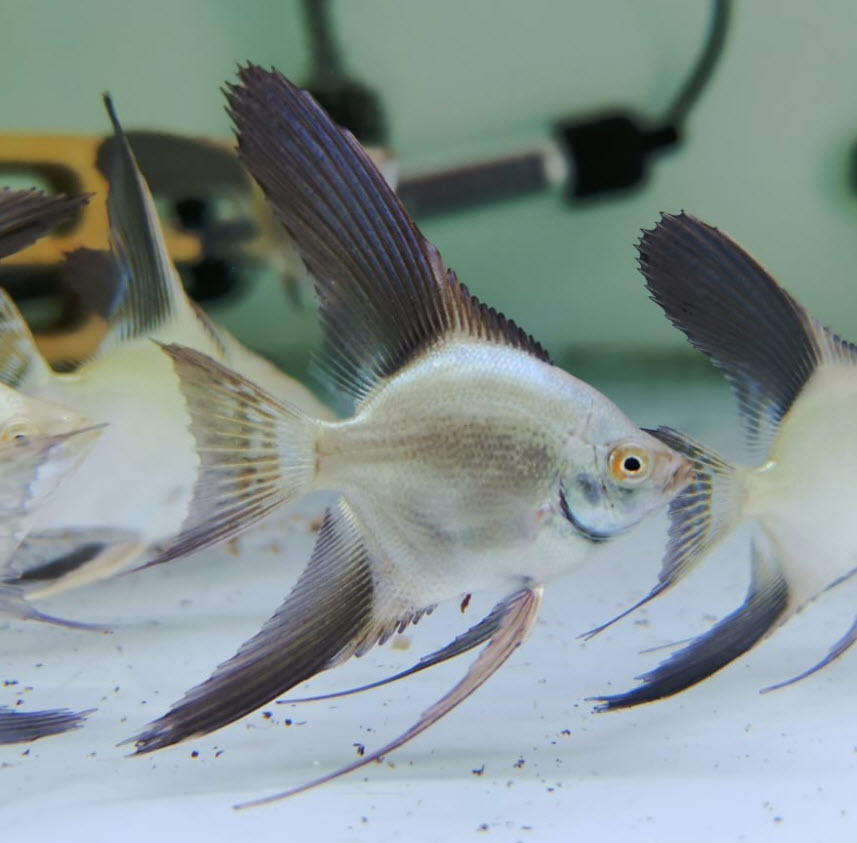
An unbiased observer who didn’t know what was in the filters was asked to read an homemade printed eye chart through the length of the water column on the forty gallon tanks. There were ten lines on the eye chart going from large to small. The observer was able to read lines down this far:
- With no food additions, tanks only, new clean water, the observer could read the eighth line down (the third smallest print) on all four tanks. This would correspond to crystal clear water.
- These are the numbers for the media over the span of 90 days. Eight is crystal clear water. Six is “dull” water. Four is “cloudy” water.
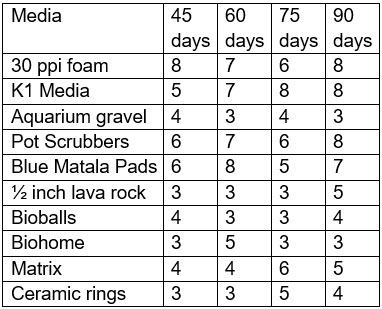
Note this data can be easily misinterpreted. The data is not linear. So interpretation is difficult. The only media which gave crystal clear water in 45 days was the foam. The only media which got to “crystal clear” state in 90 days was the foam, the K1 and the pot scrubbers. All indications are that under normal conditions all these media are quite capable of meeting what is called a “dull state”, given enough time. But transitioning to a “crystal clear” state requires a quantum leap.

This data was not the expected outcome of this test. It was expected that, based on the ammonia test, the foam, pot scrubbers and the K1 would give crystal clear water while the lava rock and ceramic rings would give very cloudy water, with everything else in between. This obviously was not the case. The data indicates a “threshold”, above which crystal clear water can be seen, below which it can’t be seen.
And surprisingly there does not appear to be significant time dependency beyond the initial 45 days of cycling. It was expected that, if left uncleaned, even the very poor media such as ceramic rings would produce crystal clear water in time. This was NOT the case.
This is an easy test easily replicated by any hobbyists interested in accuracy. This was very deliberate. We deliberately avoided the type of test which might be “scientifically correct” but difficult to reproduce at home.
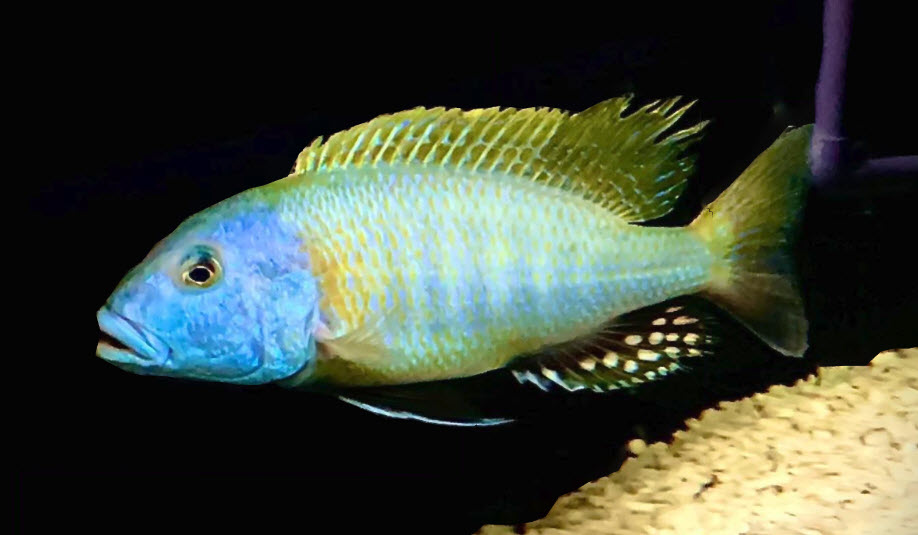
Replications at Lower Filtration Levels
Forty gallon tanks (five forty gallon aquariums set up twice) were then set up with five Sunsun HW304 B filters filter at half loading of the canister. Various media (~one fourth cubic feet) was then placed in the filter.
The first study was then rerun:
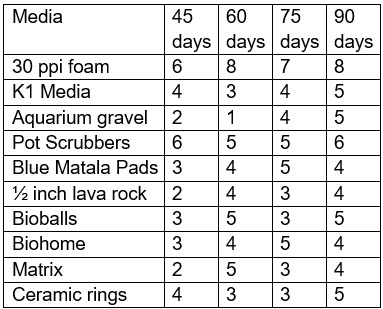
The fact that pot scrubbers, Matala pads and K1 only gave dull water indicates that crystal clear water needs a minimum of twenty times the surface area of ammonia oxidation, namely 100 square feet of surface area per pound of fish. This confirms the data of the first test on water clarity quite well. This test pointed out that it is the surface area of the filter media which is the important variable in determining crystal clear water.

Replications at Higher Filtration Levels
A third test was then run. Forty gallon tanks were then set up with two Sunsun HW304 B filters filter at full loading of the canisters. Various media (~one cubic feet) was then placed in the two filters per aquarium. Only five media were used.
The first study was then rerun:
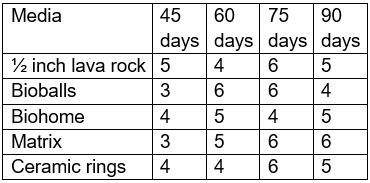
This was unexpected. Even at a very high volume these media did not give crystal clear water. All five of these media gave dull water in ALL the tests. This shows that foam is at least four times better than any of these five media for creating healthy crystal clear water. Based on surface area it is estimated that these medias are only 5 to 10% as efficient as foam, which is exactly what was found in the ammonia oxidation test.
Note that it also proves the surface area claims of media such as Matrix and Biohome is just marketing hype. These expensive media are not good filter media, especially if one want’s crystal clear water.
Also note that this water clarity testing reveals the reason the vast majority of photos of aquariums on social media have water which is “dull” at best and definitely not “crystal clear”. The hobbyists have enough media surface area for ammonia oxidation but not enough surface area for crystal clear water. Aquariums with truly crystal clear water are very rarely seen on social media.
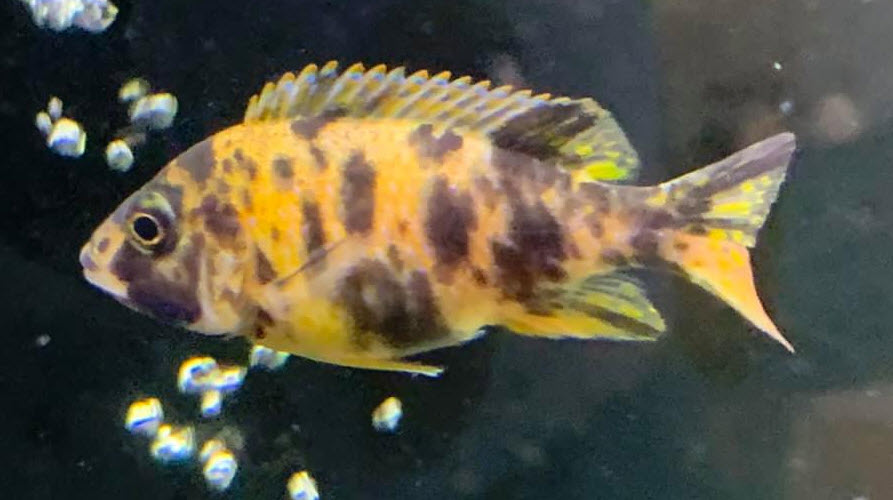
A Fourth Test
The five 40 gallon breeder aquariums used in the water clarity test were needed as grow out tanks for some Lake Malawi Cichlids. So just for some reality a test was set up. The tanks were set up as above with Sunsun HW 304 B canister filters and wavemakers just as above. Each canister was filled with one of five media:
- Static K1 media
- plastic pot scrubbers
- Matrix
- Biohome
- Alfragrog
The Alfragrog was just a “impulse buy” that was included for some variety. Each of the five aquariums and canister filters was rapid cycled with ammonia, food and sponge filter rinsing’s inoculate. A large number of Lake Malawi Fry were then placed in each aquarium and grown out for five months.

After two months of operation three aquariums went crystal clear: Static K1 media, plastic pot scrubbers and the Alfragrog. Two aquariums had noticeably “dull” water: the Matrix and the Biohome. This relationship then held for three more months.
The performance of the K1, pot scrubbers Matrix and Biohome was completely in line with all the other 55 tests. So this was no surprise.
The Alfragrog performance was a complete and total surprise. It should not have been able to produce crystal clear water. Just goes to show when you think you have everything figured out Mother Nature will throw you a curve.
Alfragrog is a product out of the United Kingdom. When someone in England commented on it I thought they were talking about a beer. It has a very rough surfaced ceramic of some sort. It has very limited availability (only one supplier in the US I could find) and the company may be out of business. One shouldn’t read too much into one aquarium test but it was a surprise.

Test Interpretation
What this can translate to is illustrated by the number of fish a typical canister will handle stocked with some of these media (crystal clear water and very healthy fish):
- Foam
36 five-inch fish
- Static K1 media
24 five-inch fish
- Ceramic rings, Lava Rock
4 five-inch fish
These are some huge differences.
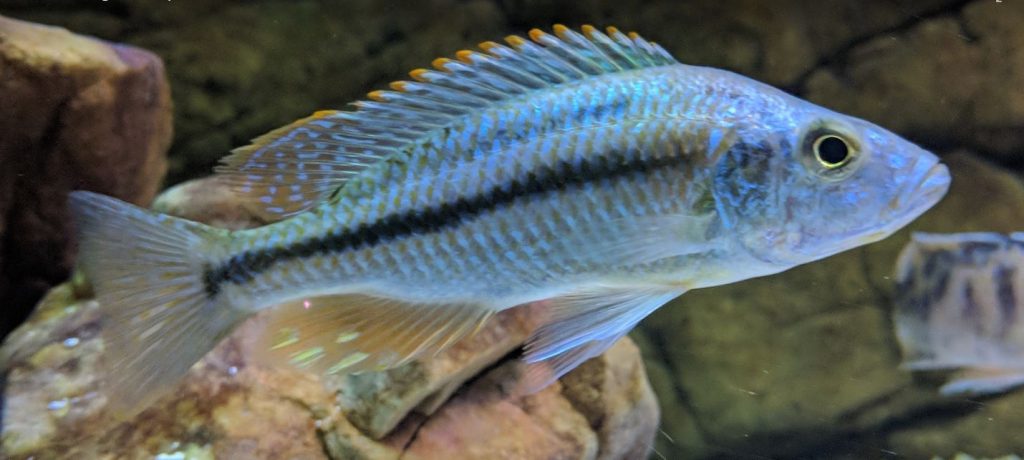
The Math
This is the boring math of this test.
- Each canister has one half cubic foot for media
- Foam has an EFFECTIVE surface area of roughly 400 ft2/ft3
- This mean the canister of 30 ppi foam had 200 square feet of surface area.
- K1 has an effective surface area of 260 square feet per cubic foot or 130 square feet of surface area in this canister.
- Fish metabolize 75% of the food they eat to carbon dioxide or body mass, leaving only 25% to form DOCs and cloud the water. An additional 5% DOCs comes from uneaten food. This totals 30%.
- One pound (454 grams) of fish needs 1.5% or 6.81 grams of food per day
- So one pound of fish being fed 6.81 food daily is the equivalent of feeding a tank without fish 30% x 6.81 or 2.04 grams of food.
- So two grams of food daily without fish is the equivalent of feeding one pound of fish
- So one pound of fish will have crystal clear water with 200 square feet of surface area but not 130 square feet of surface area.
- These numbers are very very rough and very open to interpretation, obviously.
This test shows that “crystal clear water” requires at least twenty times the EFFECTIVE surface area of just ammonia oxidation, i.e. AT LEAST one hundred square feet of surface area per pound of fish.
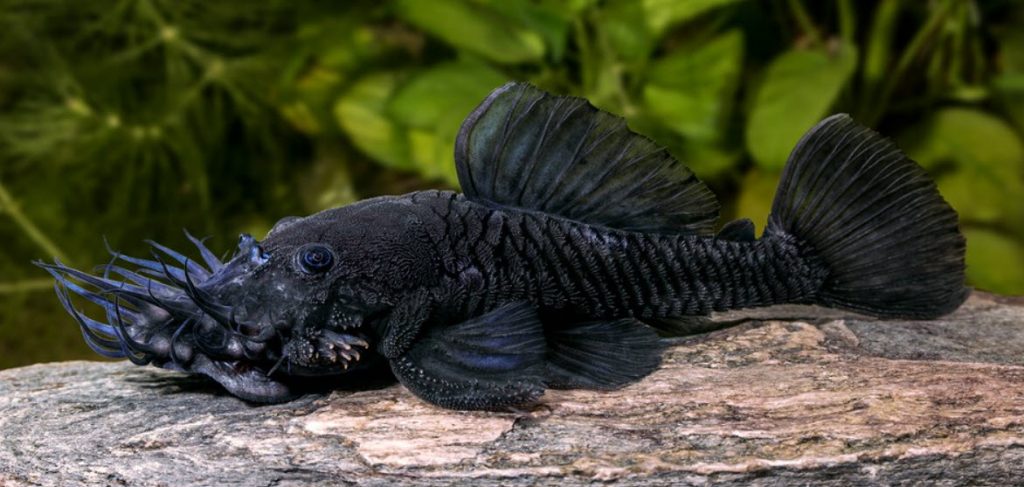
It should be noted that crystal clear water appears to need three things:
- 100 square feet of EFFECTIVE surface area per pound of fish
- Very good aeration
- Reasonably high flow through the filter, at least two turn-overs per hour of the tank.
The important item here is that there is one “GUIDELINE“:
.
One Pound of Fish Needs 100 Square Feet of Biomedia Surface Area to have Crystal Clear Healthy Water
.
It has to be noted that ammonia oxidation only appears to require a surface area of five square feet per pound of fish, only 5% of what crystal clear healthy water requires.
Note this is a GUIDELINE. Clear, healthy water is a product of many variables such as aeration, water movement, and flow over the filter media. But the testing above indicates surface area is very important and that the 100 square feet figure is accurate for a well aerated aquarium with decent flow.

What this says is that a media with 5 square feet per cubic feet of effective surface area will oxidize ammonia for one pound of fish. However crystal clear healthy water requires 100 square feet per pound of fish. Note this surface area rule is supported in the literature (“Understanding Biological Surface Area in Aquaponics”, Michael, 2016, note this reference has disappeared from the web as of 01/02/2022).
“Remember: as an absolute minimum, your system needs at least: 5 ft2 of biological surface area/pound of fish (at low stocking densities and low feeding rates). For a healthier system, we would recommend: 100 ft2/pound of fish.”
This bears repeating:
.
“For a healthier system, we would recommend: 100 ft2/pound of fish.”
.
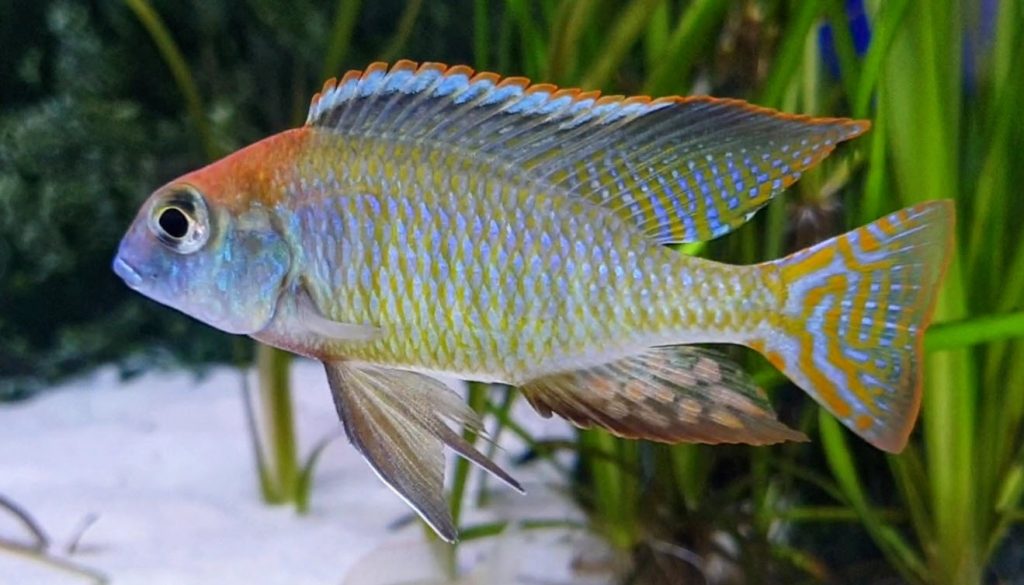
Alternatives
It is important to note that 100 square feet of surface area per pound of fish is just one of three methods that can produce crystal clear water. All three methods are:
- 100 square feet of filter media surface area per pound of fish
- A polishing filter media such as Polyfil (polyester fibers), polyester mats (Pinkie Pads) or 40 ppi foam. The downside to this is that the media needs to be replaced every 3 to 10 days, depending on the stocking in the tank. This polishing media can also cut down considerably on the flow through a filter.
- A UV setup left on 24/7 kills the bacteria and infusoria in the water column. The author is not a fan of this method. UV should only be an adjunct to good filtration.

Belief Perseverance Effect
Many people who spent a great deal of money on the media they have in their filter will say this test is wrong for this reason and that reason. This is the psychological phenomenon of “belief perseverance effect”. People will rationalize and rationalize any science away which doesn’t coincide with their beliefs. It is pointless to try and fight this phenomenon.
.
“Nothing dies harder than a lie people want to believe” Calvin
.
Ammonia Oxidation Test of Aquarium Filter Media
Another series of tests were run on the ammonia oxidation capabilities of each media. These tests show that ammonia oxidation only requires about 5% of the surface area that clear water requires. This test can be found at this link:
7.1.3. Filter Media Ammonia Oxidation Test
.
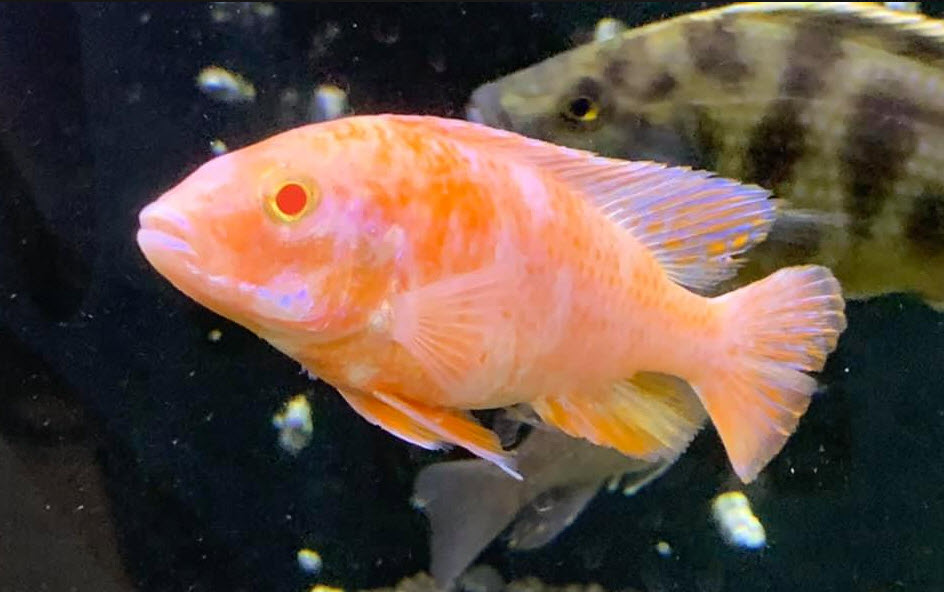
Each Specific Filter Media
This is an index of articles devoted to all the various filter media in use in filters. Each article discusses each media type in depth:
7.2.1. Polyester Floss
7.2.2. Foam and Sponge
7.2.3. K1 Media
7.2.4. Perlite and Pumice
7.2.5. Aquarium Gravel
7.2.6. PP and EVA Pads
7.2.7.Bio Balls
7.2.8. Pot Scrubbers
7.2.9. Lava Rock
7.2.10. Growstone
7.2.11. Ceramic Media
7.2.12. Matrix
7.2.13. Clay Balls
.
Return to Filter Media Menu
.
Aquarium Science Website
The chapters shown below or on the right side in maroon lead to close to 400 articles on all aspects of keeping a freshwater aquarium. These articles have NO links to profit making sites and are thus unbiased in their recommendations, unlike all the for-profit sites you will find with Google. Bookmark and browse!
.

Dave says
In reply to anonymous …. Thanks for the reference. I changed that line to be more accurate into:
“Fish metabolize 75% of the food they eat to carbon dioxide or body mass, leaving only 25% to form DOCs and cloud the water. An additional 5% DOCs comes from uneaten food. This totals 30%.”
Close enough to your reference.
Anonymous says
Just pointing out a minor error in “Fish metabolize 80% of the food they eat to carbon dioxide, leaving only 20% to form DOCs and cloud the water. An additional 10% DOCs comes from uneaten food. This total 30%.”
From pg 206 of Recirculating Aquaculture (5th ed.):
Of the organic carbon in the feed ingested, 52% ends up as CO2 through respiration, 0.7% to 3% excreted as dissolved waste, 25% excreted as poop. 22% remains in the fish as body mass.
So the final DOCs figure of 20% from the fish is accurate. But the breakdown isn’t. (Did you deliberately simplify it?)